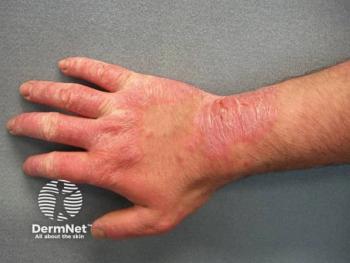
Shifting the Paradigm in Infant Atopic Dermatitis Treatment With Roflumilast
Key Takeaways
- Roflumilast offers a non-steroidal alternative for atopic dermatitis, addressing concerns about long-term corticosteroid use in infants.
- Dr. Gonzalez's involvement in pediatric trials supports roflumilast's safety and efficacy, with low adverse event rates.
Pediatric dermatologist Mercedes E. Gonzalez, MD, discusses roflumilast's promise as a safe, nonsteroidal treatment for atopic dermatitis in infants.
“When I'm seeing a patient, an infant with atopic dermatitis [AD], I'd much prefer to have a conversation to discuss the [adverse] effect profile of roflumilast than having to discuss the [adverse] effect profile of a topical corticosteroid,” Mercedes E. Gonzalez, MD, told Dermatology Times.
Gonzalez, who also serves as faculty at Larkin Community Hospital South Miami and the University of Miami Department of Dermatology in Florida, shared insights from her extensive experience in pediatric dermatology research,
Gonzalez has previously served as an investigator in both the MUSE and Integument-PED trials, which included children aged 2 to 5 years. Her unique experience with these studies, along with data from trials in adults and children aged 6 to 11 years, has given her confidence in roflumilast’s safety and efficacy profile. She reported that the medication was well tolerated by patients, with low rates of adverse events—primarily mild cases of upper respiratory infections, diarrhea, and vomiting occurring in less than 4% of participants.
As the trial moves to include younger infants, Gonzalez emphasizes her unique ability to guide families based on previous trial outcomes. She notes that roflumilast fills a critical unmet need in pediatric dermatology by offering a safe, nonsteroidal alternative to traditional topical corticosteroids, which often carry concerns about long-term adverse effects, especially in chronic use.
Gonzalez also highlighted the importance of early intervention in AD, which typically presents in infancy. She believes roflumilast could play a significant role in altering the course of the disease and potentially reducing the progression of the atopic march. Confident that enrollment will progress rapidly, she is optimistic about the trial’s timeline and is eager to see the medication eventually approved by the FDA. Ultimately, Gonzalez hopes to provide her young patients with a safer, effective treatment option that supports long-term skin health without the drawbacks of steroids.
“I think that the [number of] subjects needed to complete the trial is very attainable in a very short period of time,” Gonzalez said. “I know my site's already enrolling patients, and we're really looking forward to completing this and getting this in front of the FDA to have this in our hands to be able to prescribe for our patients.”
Newsletter
Like what you’re reading? Subscribe to Dermatology Times for weekly updates on therapies, innovations, and real-world practice tips.



















